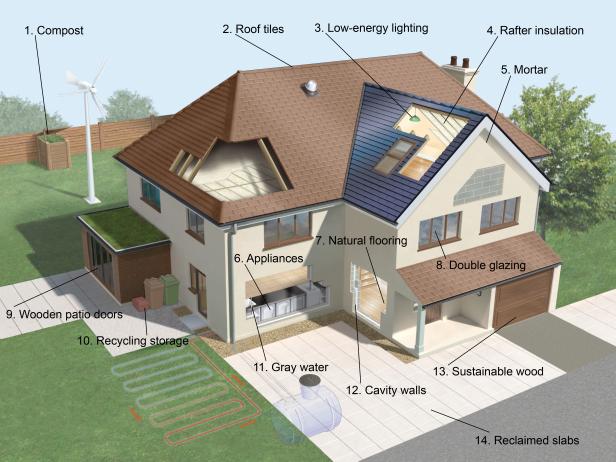Ways To Go Green and Save Money.
When assessing the green credentials of your house in the Vale of Berkeley, South Gloucestershire, or investigating where green improvements could be introduced, there are a number of areas to explore. Many green solutions are relatively straightforward, while some will involve major upheaval and may be more suited to a new-build project than a retrospective fit. Use the information given here as a link to more detailed analysis later in the book. You will see that there are greener options for nearly all aspects of DIY.
Green Research
There are advantages and disadvantages with any building technique or material, and Eco-friendly options are no different. If possible, it is always important to substantiate a manufacturer’s claims with hard evidence. As in any aspect of life, manufacturers are concerned primarily with selling goods, so it is necessary to compare products, research different ideas, and make sure they meet your own needs. The areas covered here deal with most aspects of what is currently available in terms of making your home a greener place to live. Using the relevant page references, you can refer to various parts of the book for more in-depth information — and to learn how to carry out green projects yourself.
If all houses featured many of these ideas, the energy usage of the population as a whole would be significantly reduced. However, the initial financial outlay must always be considered. With low-energy light-bulbs, for example, the initial cost is low, so the pay-off is fast—in terms of saving both energy and money. But with larger, more expensive projects, such as installing solar panels, the energy-saving pay-off may be quick, but it will take far longer to recoup the initial costs. The best advice is to address the key options first (insulate well, use low-energy electrical goods, and recycle), leaving the more complex projects to form part of the decision-making process of any future home improvements.

1. Compost: Making compost is the ultimate expression of green living — turn your food scraps and yard debris into fertilizer.
2. Recycled Roof Tiles: Consider using reclaimed clay or stone tiles, or slates.
3. Low-Energy Lighting: A small investment can have a large impact on saving electricity.
4. Rafter Attic Insulation: In a lived-in roof space, ensure the ceiling is insulated sufficiently.
5. Mortar: For brick or stone homes, lime mortars are far greener than those that are cement-based.
6. Appliances: Be sure to choose energy-efficient models.
7. Natural Flooring: Choose flooring from sustainable sources or materials such as bamboo and cork.
8. Double Glazing: Double or even triple glazed windows will always make your home more energy efficient.
9. Wooden Patio Doors: Double-glazed windows need not be UPVC or aluminum. Wood is a greener option and will last just as long if well it is well-maintained.
10. Recycling System: A good system of sorting materials for recycling is essential for every home.
11. Gray Water: As well as using collected rainwater in the home, you can also recycle water from sinks, baths, and showers.
12. Insulated Walls: Well-insulated exterior walls can help to further reduce your energy requirements.
13. Sustainable Wood: Make sure that any wood you use in your home comes from a sustainable source.
14. Reclaimed Slabs: It is not always necessary to buy new — consider using reclaimed bricks and patio pavers.
A large portion of your energy costs will be devoted to heating your home. For this reason, it’s important to make sure your heating system runs as efficiently as possible.
Here are some good tips for saving energy and avoiding high heating bills:
1) Before purchasing a furnace for your home, check its A.F.U.E. rating, which stands for the Annual Fuel Utilization Efficiency. Each furnace has this rating on it from the factory. The standard is about 80 percent, which measures how much heat goes into the home as opposed to going up the flue pipe. So if you have 80-percent efficient furnace, 80 percent of the heat generated in the heat exchanger is going into your home and 20 percent is going up the flue pipe and is not being used at all.
2) If you purchase a heat pump, you’ll want to check its H.S.P.F. rating, which stands for Heating Seasonal Performance Factor. This rating works basically the same as the AFUE rating for gas furnaces. Based on a scale of 1 to 10 (with 10 being the best), a minimum efficiency heat pump will rate approximately 6.6, while high efficiency units will have a rating of 8.0 or higher.
3) Change air filters for your heat pump or furnace on a regular basis. A dirty filter increases the air pressure drop in the system, which ultimately uses more energy or decreases the air flow to a point where the system isn’t working properly.
4) Have your builder or a heating specialist check the heat ducts for leakage. An HVAC professional can repair any leaks or gaps that are found.
5) Weatherize your home by weather stripping or caulking around doors and windows. This will help keep heat from your system inside the home.
6) Add programmable thermostats to your central heating system. This will help save energy by not heating your home when you’re away.
7) Keep obstructions away from heating vents. This will help promote better heat flow throughout the house.
Plumber’s Emergency Kit
1) Use a five gallon bucket as a tool holder. And if a leak springs mid-project, it’ll catch the water. A tool caddy can also be attached to the bucket providing a place for everything.
2) Keep a forced cup and a regular plunger handy. Each plunger has its own specific use and provides extra unclogging power.
3) Wrenches are essential in plumbing. A pair of medium sized slip joint pliers and an adjustable wrench should cover most jobs, along with various sized wrenches.
4) A multi-bit screwdriver can reduce the number of tools that need to be carried around on the job.
5) An assortment of Allen keys is very handy and has many uses.
6) Duct tape and leak sealing tape can help out in a plumbing emergency until a permanent fix can be made. Teflon tape will seal up leaks from around threaded connections.
7) A variety of blind caps can help you see your way through repairing a broken valve.
8) Heavy duty paper towels or rags will help clean up water from small leaks.
Emergency Tips
1) Always know where the main water shut-off valve is located in case of a leak.
2) Know how to turn off the water heater. If it’s a gas water heater, turn the switch to the “pilot” position.
3) Isolation valves located at each fixture will stop the flow of water to that location. This allows water to continue to service the remainder of the house while the leak is being repaired. It’s a good idea to turn on and off each isolation valve in the house at least once a year to keep them in good working condition.
4) Using two wrenches at once turning in opposite directions is called “backing off” and allows the wrench to absorb the stress and not the plumbing.
5) Slip joint pliers can be used to loosen the collar nuts on a drain line.
6) If a supply tube break off is causing a leak, screw in a blind cap to seal off the leak until it can be fixed.
7) Occasionally, the ferrules in a supply tube can get scratched or dented causing water to leak. Use Teflon tape around the ferrule until a permanent repair can be made.
8) Use duct tape or pipe sealing tape to pull together a crack in a pipe, reducing the leak as a temporary solution.
9) A cup plunger can be used for small drains like bath tubs, showers and lavatory sinks. Forced cup plungers have a funnel that can apply extra force down the drain, which is good for sinks or toilets.
10) When unclogging a kitchen sink, use a second plunger to cover the other drain to get the most force to remove the clog.
11) To unclog a toilet, use a forced cup plunger.
12) For bathtub clogs, unscrew the chrome cap — this exposes the entire drain. Once the mechanism is removed, you’ll be able to see the clog. Put the plunger on the drain, and then use the second plunger to plug up the tub’s overflow. Plunge the drain to remove the clog.
13) Allen wrenches are useful for working on a faucet and garbage disposals.
Solar Panels
In simple terms Solar Panels can be divided into two types:
1) Photovoltaic Solar Panels
2) Solar Thermal Collectors
Photovoltaic Solar Panels convert Photon particles from the sun into electricity, while Solar Thermal Collectors use heat from the sun to warm water or liquid contained within a network of pipes.Both technologies can be considered eco friendly as neither generates carbon as a by product, and both can be used by households to reduce their heating and electricity bills.
Solar panels:
1) Photovoltaic
2) Thermal
3) Solar Tiles
Home / Community Wind Turbines
The UK has one of the largest potential wind energy resource in Europe and wind power is currently one of the most developed and cost effective renewable energy technologies.
The modern wind turbine is quiet and is available in different sizes, depending on the required output. A small unit can attach directly to the roof and larger units require their own support post.
When the wind blows the blades of a wind turbine, the blades rotate a shaft. A generator converts the energy from the rotating shaft into electrical energy which can be used in a household to power electrical appliances, reducing electricty bills and reliance on fossil fuel energy generation.
Domestic wind turbines can either be integrated into the local electricity grid or operate as off-grid devices, charging batteries when excess electricity is generated. Depending on their site, a small scale domestic wind turbine can be an effective renewable energy option in terms of energy output. The best sites are those with an average annual wind speed of at least 5 metres per second and with an unobstructed flow of wind.
Technologies
Horizontal or vertical axis turbines, mostly on freestanding poles but can be mounted on buildings.
Installed cost
Small 1kW building mounted wind turbines cost around £2,000. A typical 6kW pole mounted turbine costs around £22,500.
Grants available
Call the Energy Saving Trust on 0800 512 012 for details of any local support available.
Other financial
Eligible for Feed-in Tariffs payments – see Government Incentives support section. For more information visit energysavingtrust.org.uk
Running costs
None.
Savings
A 6kW turbine could generate income and savings of around £3,200. Includes FITs payment.
Maintenance
A regular annual maintenance check is usually required.
Space issues
The greater the distance between a wind turbine and any obstructions such as trees or buildings the better the wind resource and energy output will be.
Energy availability
Dependent upon wind speeds which fluctuate throughout the day and are often lower in spring/summer than autumn/winter. Also very dependent on site.
Planning issues
Needs planning permission from your local authority. It’s also advisable to discuss the installation with neighbors.
Installer issues
Choose an installer certified under the Microgeneration Certification Scheme – see microgenerationcertification.org. Check the installer is a member of the REAL Assurance Scheme visit realassurance.org.uk for more information. CO2 emissions Savings will depend on local wind speeds. A well sited 6kW installation could save over 5 tonnes of CO2 per year.
Other issues
The output of a wind turbine is determined by the wind speed at the site of the turbine, which depends on the location, height, and nearby obstructions. Wind turbines should only be considered if the average wind speed is at least 5 metres per second. You can get an initial indication of this by using our domestic wind speed prediction tool energysavingtrust.org.uk/windspeedtool
WINDOWS
The average house looses a good amount of heat through it’s windows. This heat loss can be reduced through simple measures such as fitting double or triple glazing, or even simply by hanging heavy insulating curtains.
Installing double glazing can cut heat loss through windows by half. If you can’t afford to replace all the windows, why not choose the rooms that cost you the most to heat.
Ideally double glazing should have wide cavities between the two glass panes. 16mm is the optimum distance. If the cavity being filled with an inert gas, usually argon, the window will be even more efficient.
Low-impassivity coatings being added to the glass can also stop heat escaping.
Designing out cold bridges, such as aluminum spacers, surrounding the glazed units also increase the efficiency of the window.
Large efficient windows can be angled to avoid summer heat and to maximize the small amount of winter energy from the sun – a principle is known as passive solar heating. See Angled Windows House for an example of this.
Triple glazing
Solar windows
PLUMBING:
Water is a precious resource even in a relatively wet part of the world such as the UK, as a large amount of energy is required to collect, purify and deliver water to households up and down the country.
This energy requirement makes us further dependent on fossil fuels. The main cause of water waste in the home is old and wasteful sanitary-ware such as toilets, baths and taps. There are a number of solutions available to help households save water and deal with waste water in an environmentally friendly way.
Plumbing:
Composting toilet
Rainwater collection
Water saving toilets
Water storage
BioRock Sewage Treatment Tanks


 Vale, Gloucestershire garden will give the whole family something to watch, listen to and learn about. And not only that, you’ll also be helping the environment by encouraging some of the rarer creatures to take up residence or feed in your outdoor room.
Vale, Gloucestershire garden will give the whole family something to watch, listen to and learn about. And not only that, you’ll also be helping the environment by encouraging some of the rarer creatures to take up residence or feed in your outdoor room. they simply become less active in colder weather. So encourage them back into your garden on warm, sunny winter days with the promise of food with winter-flowering plants like crocus.
they simply become less active in colder weather. So encourage them back into your garden on warm, sunny winter days with the promise of food with winter-flowering plants like crocus.
 variety of invertebrates such as snails and slugs, beetles, caterpillars and worms.
variety of invertebrates such as snails and slugs, beetles, caterpillars and worms.